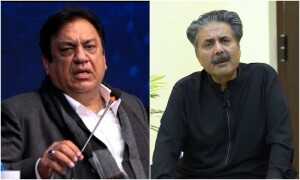KARACHI: While expressing their disquiet about safety of residents living within the 30-kilometre radius of a nuclear power plant site in Karachi, a group of concerned citizens at a meeting on Tuesday sought more information from the federal government about the $10 billion project.
Speaking at a programme held at The 2nd Floor, the speakers raised concern over lack of environmental assessment in order to curtail possible hazards from the construction of the nuclear project at a site that they said had “outlived its design age”.
Read: SHC stops PAEC from starting work on N-plants
The group’s concern is not a recent one. They had come together after the government announced the nuclear power plant project in December last year. The project will include the construction of two power plants at Kanupp. The reactors will be purchased from China National Nuclear Corporation, with assistance coming largely from the Chinese government.
According to architect Arif Belgaumi, who presented details of the project, several meetings were held after the project was introduced. “Our aim was to speak about the need of conducting a public Environmental Impact Assessment to address public reservations against the project.” He explained that they were not against the power plant but its proximity to urban areas.
“Kanupp was built in the late 1960s, but then the city was smaller than it is now. However, Karachi has grown since then and is now one of the largest cities in the world. This is what we are concerned about. The world has witnessed two major accidents at nuclear power plants. One is the disaster in Chernobyl, Ukraine, in 1986. And the other occurred in Fukushima, Japan. Following the catastrophic accident at Fukushima in 2011, worldwide review of nuclear reactor safety has begun.”
He added, “What came to the fore after the explosion at Chernobyl, Ukraine, was that an area within the radius of 30kms from the plant was declared hazardous. Karachi lies within the 30km radius from Kanupp and in case a disaster occurs, it will affect the lives of 8.2 million residents, which is the largest number of residents around any nuclear reactor all over the world.”
Read: Earthly matters: Shutting down KANUPP
At present, the Pakistan Nuclear Regulatory Authority (PNRA) and Pakistan Atomic Energy Commission (PAEC) are presenting their arguments in the Sindh High Court (SHC), after a small number of citizens and activists filed a petition in the SHC, which in return passed a stay order until a public EIA is conducted.
Barrister Abdul Sattar Peerzada, who is also one of the petitioners, said that not many people knew about a nuclear reactor being built 30kms from residential areas. “The Pakistan Environmental Protection Act, 1997 says that before the commencement of a project on such a large scale, a public notice in both English as well as Urdu language newspapers will be published. Date and time of a public hearing should also be mentioned in such a notice. Basically, it means sending out an invitation to the public to participate. But in this case, there was no notice in the newspapers.”
He added that only four days back both PAEC and PNRA filed their replies in the SHC that sounded “absolutely abysmal”. Explaining, he said their response was focused on the fact that there was “no need for a public hearing. And they also say that they are complying with the law, as they have a ‘No Objection Certificate’ to do so. What they are conveniently forgetting is that this is not an apartments block they are building rather a nuclear reactor.”
A member from the audience asked if such hearings had enough teeth to stop such a project. Replying to that, Barrister Peerzada said: “Such hearings do matter. A major part of the population does not know their rights. The newly added article in the Constitution, 19-A, gives a common man the right to information. Nobody is asking them to divulge top secret details. We are only asking them to give us information about what, when, how and why.”
Mr Belgaumi added that most of the information, especially in such matters, “is kept a secret under the guise of it being a matter of national security, which doesn’t make sense”.
Also read: ‘Nuclear plant project okayed after secret EIA hearing’
An activist with Shehri, Roland D’Souza, said: “If the ruling comes in our favour, we should ask for a period of 30 to 60 days to study the hazards due to the complexity of the case and look at how such matters have been taken up or followed in India and European countries.”
Among the hazards, Mr Belgaumi stated in his presentation, “20 earthquakes with a magnitude of 7.0 on the Richter scale are known to have occurred in the south region since 1668, making it extremely vulnerable to Tsunami as well as tidal waves.”
He said a proper task analysis, environmental assessment, taking local administration in confidence and approval of the EIA before initiating work at Kanupp would be better before constructing a nuclear reactor.
Published in Dawn, November 12th, 2014















































